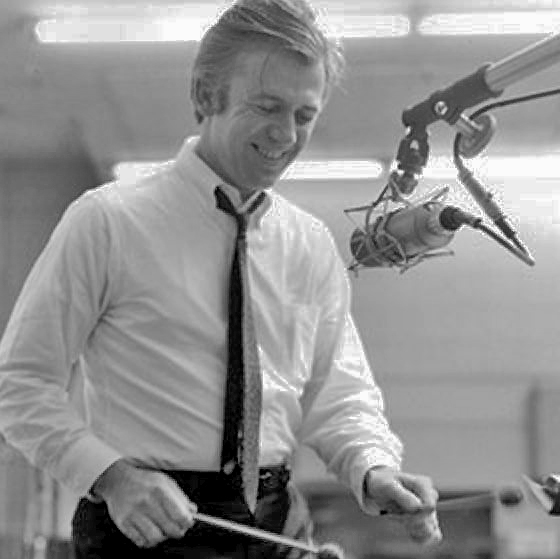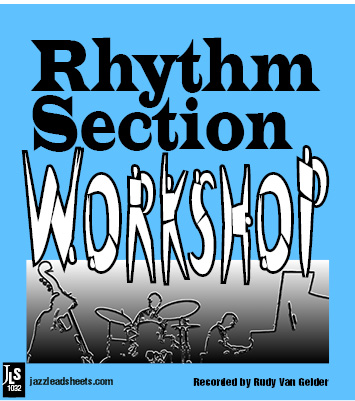Kitch – Gary McFarland
This bright, charming swinger was never recorded by Gary McFarland but he did arrange the Piano part that we use as the basis for our Rhythm Section Workshop recording (complete with Minus You tracks for piano, bass, and drums).
- Recording: SFM Trio - Rhythm Section Workshop
- Recorded on: January 25, 2014
- Label: jazzleadsheets.com (JLS 1032)
- Concert Key: C
- Vocal Range: , to
- Style: Swing (medium up)
- Piano - Ben Rosenblum
- Bass - Ben Rubens
- Drums - Ben Zweig
Video
- Description
- Historical Notes
- Solos
- Piano Corner
- Bass Corner
- Drum Corner
- Guitar Corner
- Inside & Beyond
- Minus You
Fortunately, we have Gary's piano arrangement of the melody (see Historical Notes); because of that it was easy for us to make lead sheets so any instrument can be featured playing the melody.
A medium-up swinger with a bright sound and lots of rhythmic drive. The melody is simple and mostly diatonic, but rhythmically diverse; many phrases begin on the "and" of beat 1 or on beat 2. In the bridge, the melodic motion is mostly chromatic. The chord progression consists entirely of dominant 7ths, with 4th-based motion broken up by a few chromatic side-slips. The solo form is 32 measures, but the head adds a 4-measure tag at the end.
In this trio version, the bass and drums play with a 2-feel on the A sections, going to 4-feel on the bridge. There are stop-time figures at the ends of the two A sections, as well as a series of hits in the first two measures of the C section that alternate with the melody notes (different from the A section melody) to create a series of dotted quarter notes. The coda consists of a descending bluesy phrase at half the tempo, harmonized in dissonant voicings of mostly 4ths and tritones. The bass doubles the melody line of this figure.
A medium-up swinger with a bright sound and lots of rhythmic drive. The melody is simple and mostly diatonic, but rhythmically diverse; many phrases begin on the "and" of beat 1 or on beat 2. In the bridge, the melodic motion is mostly chromatic. The chord progression consists entirely of dominant 7ths, with 4th-based motion broken up by a few chromatic side-slips. The solo form is 32 measures, but the head adds a 4-measure tag at the end.
In this trio version, the bass and drums play with a 2-feel on the A sections, going to 4-feel on the bridge. There are stop-time figures at the ends of the two A sections, as well as a series of hits in the first two measures of the C section that alternate with the melody notes (different from the A section melody) to create a series of dotted quarter notes. The coda consists of a descending bluesy phrase at half the tempo, harmonized in dissonant voicings of mostly 4ths and tritones. The bass doubles the melody line of this figure.
"Rhythm Section Workshop" was recorded at the legendary Van Gelder Studio in Englewood Cliffs.
Printed music of this composition was made available in 1964, in a folio called "The McFarland Touch," subtitled: "Exciting Jazz Compositions Presented As Piano Solos." Gary arranged ten of his compositions for this book.
Gary's arrangements are different from our normal Solo Piano Arrangements in that the left hand of Gary's arrangements are comping voicings, mostly without roots. Playing it as a solo piano piece probably won't be as satisfying as playing it with a bass player, who would cover the missing roots of the chords. However, Gary's piano arrangements are perfect for Rhythm Section Workshop arrangements.
Our Rhythm Section Workshop piano part was taken from "The McFarland Touch" book. The only real change we made was to insert a solo section and make the last three measures of his single chorus arrangement a coda, to close out the arrangement after repeating the melody for the out chorus.
Since Gary never got to record this composition, we feel our approach is very important, since it preserves his thoughts about the piece through his piano arrangement. Our trio had a ball using his clever arrangement as the rhythmic source for their interpretations.
This printed version of Kitch was the source of inspiration for Mark Master's arrangement, which, in 2005, became the first recorded arrangement. On Masters' "Wish Me Well," the tentet version (the instrumentation is a "Birth Of The Cool"-style nonet plus tenor sax) has a different C section that is the same as the A section. It also lacks some of the stop-time hits from McFarland's solo piano arrangement.
Printed music of this composition was made available in 1964, in a folio called "The McFarland Touch," subtitled: "Exciting Jazz Compositions Presented As Piano Solos." Gary arranged ten of his compositions for this book.
Gary's arrangements are different from our normal Solo Piano Arrangements in that the left hand of Gary's arrangements are comping voicings, mostly without roots. Playing it as a solo piano piece probably won't be as satisfying as playing it with a bass player, who would cover the missing roots of the chords. However, Gary's piano arrangements are perfect for Rhythm Section Workshop arrangements.
Our Rhythm Section Workshop piano part was taken from "The McFarland Touch" book. The only real change we made was to insert a solo section and make the last three measures of his single chorus arrangement a coda, to close out the arrangement after repeating the melody for the out chorus.
Since Gary never got to record this composition, we feel our approach is very important, since it preserves his thoughts about the piece through his piano arrangement. Our trio had a ball using his clever arrangement as the rhythmic source for their interpretations.
This printed version of Kitch was the source of inspiration for Mark Master's arrangement, which, in 2005, became the first recorded arrangement. On Masters' "Wish Me Well," the tentet version (the instrumentation is a "Birth Of The Cool"-style nonet plus tenor sax) has a different C section that is the same as the A section. It also lacks some of the stop-time hits from McFarland's solo piano arrangement.
Although Gary's Solo Piano Arrangement was published in 1964, in a folio called "The McFarland Touch" subtitled: "Exciting Jazz Compositions Presented As Piano Solos," playing it as a solo piano piece probably won't be as satisfying as playing it with a bass player, who would cover the missing roots of the chords. However, the arrangement is perfect for our Rhythm Section Workshop. The Piano part available here is as Gary wrote it. See the Historical Notes tab for more information.
Gary McFarland's clever piano arrangement is our piano part for this great trio workout.
Exclusive Minus You audio tracks Piano, bass, and drum parts are available.
CLIP The format of this recording is:
-- melody
-- piano solo 2 choruses
-- bass solo 2 choruses
-- piano and drums trade 8s 1 chorus
-- piano and drums trade 4s 1 chorus
-- out melody
-- coda
mp3 minus Piano
-- count off sets up the melody
-- play the melody
-- solo 2 choruses
-- comp for the bass solo 2 choruses
-- trade 8s with drums 1 chorus
-- trade 4s with drums 1 chorus
-- play the out melody and coda
mp3 minus Bass
-- count off sets up the melody
-- 2-feel, 4-feel and figures as indicated for the melody
-- walk for the piano solo 2 choruses
-- solo 2 choruses
--walk for the piano/drums trading
1 chorus 8s
1 chorus 4s
-- 2-feel, 4-feel and figures as indicated for the out melody and coda
mp3 minus Drums - sticks on this recording, but brushes could also be used
-- count off sets up the melody
-- comp and play figures for the melody
-- comp for the piano and bass solos (2 choruses each)
-- trade 8s with piano (piano first) 1 chorus - CLIP snaps have been added during trading
-- trade 4s with piano (piano first) 1 chorus
-- comp and play figures for the out melody and coda
Exclusive Minus You audio tracks Piano, bass, and drum parts are available.
CLIP The format of this recording is:
-- melody
-- piano solo 2 choruses
-- bass solo 2 choruses
-- piano and drums trade 8s 1 chorus
-- piano and drums trade 4s 1 chorus
-- out melody
-- coda
mp3 minus Piano
-- count off sets up the melody
-- play the melody
-- solo 2 choruses
-- comp for the bass solo 2 choruses
-- trade 8s with drums 1 chorus
-- trade 4s with drums 1 chorus
-- play the out melody and coda
mp3 minus Bass
-- count off sets up the melody
-- 2-feel, 4-feel and figures as indicated for the melody
-- walk for the piano solo 2 choruses
-- solo 2 choruses
--walk for the piano/drums trading
1 chorus 8s
1 chorus 4s
-- 2-feel, 4-feel and figures as indicated for the out melody and coda
mp3 minus Drums - sticks on this recording, but brushes could also be used
-- count off sets up the melody
-- comp and play figures for the melody
-- comp for the piano and bass solos (2 choruses each)
-- trade 8s with piano (piano first) 1 chorus - CLIP snaps have been added during trading
-- trade 4s with piano (piano first) 1 chorus
-- comp and play figures for the out melody and coda
Related Songs
Email Send Kitch to a friend
Send this page to a friend via email. Add your name or email in the first field. In the second, add one or more email addresses, separated by a comma.

Gary McFarland
October 23, 1933 – November 3, 1971
Gary McFarland, though not a well-known name today, was one of the most important forces in orchestral jazz and bossa nova in the mid-20th century. Critic Gene Lees aptly described him as an "adult prodigy;" his compositions and arrangements were regarded as complex, sensitive, emotional, and sometimes delightfully simple. He was a talented vibraphonist and singer as well. Read more...
There was a problem.
...

